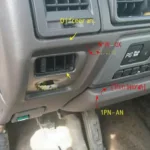An OBD2 transmission scanner is an essential tool for anyone who wants to understand and fix their vehicle’s transmission problems. It’s more than just a code reader; it’s a window into the complex world of your gearbox, offering insights that can save you time and money. Whether you’re a DIY mechanic or a seasoned professional, choosing the right obd2 transmission scanner can be the difference between a quick fix and a costly headache.
Having the right scanner can save you hundreds, even thousands of dollars in repair bills. Imagine being able to diagnose a transmission issue yourself before heading to the mechanic. An OBD2 transmission scanner gives you that power. It allows you to read and interpret the diagnostic trouble codes (DTCs) related to your transmission, pinpointing the source of the problem. More advanced scanners even offer live data streaming, enabling you to monitor critical transmission parameters in real-time. If you’re looking for a reliable way to tackle transmission woes, an bafx obd2 for abs and transmission codes could be your solution.
Understanding the Power of an OBD2 Transmission Scanner
What makes an OBD2 transmission scanner so powerful? It’s the ability to communicate directly with your vehicle’s transmission control module (TCM). The TCM is the brain of your transmission, responsible for managing everything from shifting gears to monitoring fluid levels. By accessing the TCM, the scanner can retrieve valuable data about the inner workings of your gearbox.
Why You Need an OBD2 Transmission Scanner
- Early Detection: Identify minor issues before they escalate into major problems, saving you money on expensive repairs.
- Accurate Diagnosis: Pinpoint the exact cause of transmission problems, avoiding unnecessary guesswork and part replacements.
- Empowerment: Take control of your vehicle’s maintenance and avoid being reliant solely on mechanics.
- Cost Savings: Diagnose issues yourself and potentially avoid costly diagnostic fees at a repair shop.
Choosing the Right OBD2 Transmission Scanner
With a plethora of scanners available, selecting the right one can feel overwhelming. Consider these factors:
- Compatibility: Ensure the scanner is compatible with your vehicle’s make, model, and year. Not all scanners are created equal, and some may not be compatible with older or newer vehicles.
- Features: Basic scanners read and clear codes, while more advanced models offer live data, bi-directional control, and specific transmission functions. An obd2 scanner for transmission can offer a range of functionalities.
- Budget: Scanners range from affordable basic models to high-end professional tools. Determine your needs and budget before making a purchase.
- User-Friendliness: Look for a scanner with an intuitive interface and easy-to-understand software.
Features to Look For
- Live Data Streaming: View real-time transmission data like fluid temperature, pressure, and gear position.
- ABS and SRS Codes: Some scanners can also read and clear codes related to the anti-lock braking system (ABS) and supplemental restraint system (SRS). Check out options like the innova 6200p obd2 scanner abs srs transmission code 6100p for these advanced features.
- Specific Transmission Functions: Certain scanners offer specialized functions like transmission relearn procedures, which are crucial after certain repairs. An option like an obd2 scanner with transmission relearn can be extremely beneficial.
Common Transmission Trouble Codes and Their Meanings
Understanding common transmission trouble codes can help you diagnose and address issues effectively. Some common codes include:
- P0700: Transmission Control System Malfunction
- P0705: Transmission Range Sensor Circuit Malfunction (PRNDL Input)
- P0715: Input/Turbine Speed Sensor Circuit Malfunction
- P0730: Incorrect Gear Ratio
What to Do When You Encounter a Code
- Research the Code: Look up the specific code online or in a repair manual to understand its meaning.
- Check Connections: Inspect the wiring and connectors related to the transmission for any damage or loose connections.
- Consult a Professional: If you are unsure about the diagnosis or repair, seek the advice of a qualified mechanic. A tool like the bafx 34t5 obd2 scanner read transmission codes can help you retrieve these codes accurately.
 Transmission Parts Diagram
Transmission Parts Diagram
Conclusion
Investing in an obd2 transmission scanner is a smart move for any car owner. It empowers you to take control of your vehicle’s maintenance, diagnose problems accurately, and potentially save money on costly repairs. By understanding the power and functionality of these scanners, you can keep your car running smoothly for years to come.
FAQ
- What is an OBD2 transmission scanner? A specialized diagnostic tool that reads and interprets transmission-related trouble codes.
- How do I use an OBD2 transmission scanner? Connect it to your vehicle’s OBD2 port and follow the scanner’s instructions.
- Can I fix my transmission myself with a scanner? A scanner helps diagnose the problem, but repairs may require professional assistance.
- Are all OBD2 transmission scanners the same? No, they vary in features, compatibility, and price.
Common Scenarios
- Slipping Transmission: The scanner can pinpoint the cause, whether it’s a faulty sensor, low fluid, or internal damage.
- Rough Shifting: Diagnose issues with solenoids, valves, or other components affecting shifting smoothness.
- Check Engine Light: Identify if the check engine light is related to a transmission problem.
Further Reading
For more information on OBD2 scanners and car diagnostics, explore other resources on our website. Check out our articles on specific scanner models and troubleshooting guides.
Need help? Contact us via WhatsApp: +1(641)206-8880, Email: [email protected] or visit us at 789 Elm Street, San Francisco, CA 94102, USA. Our 24/7 customer support team is always ready to assist.

